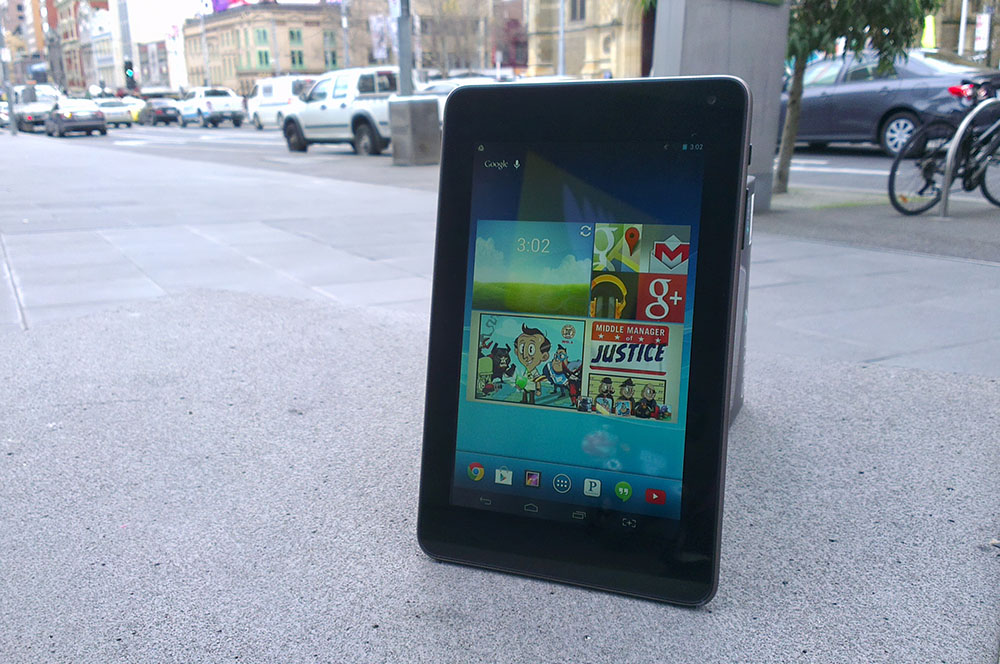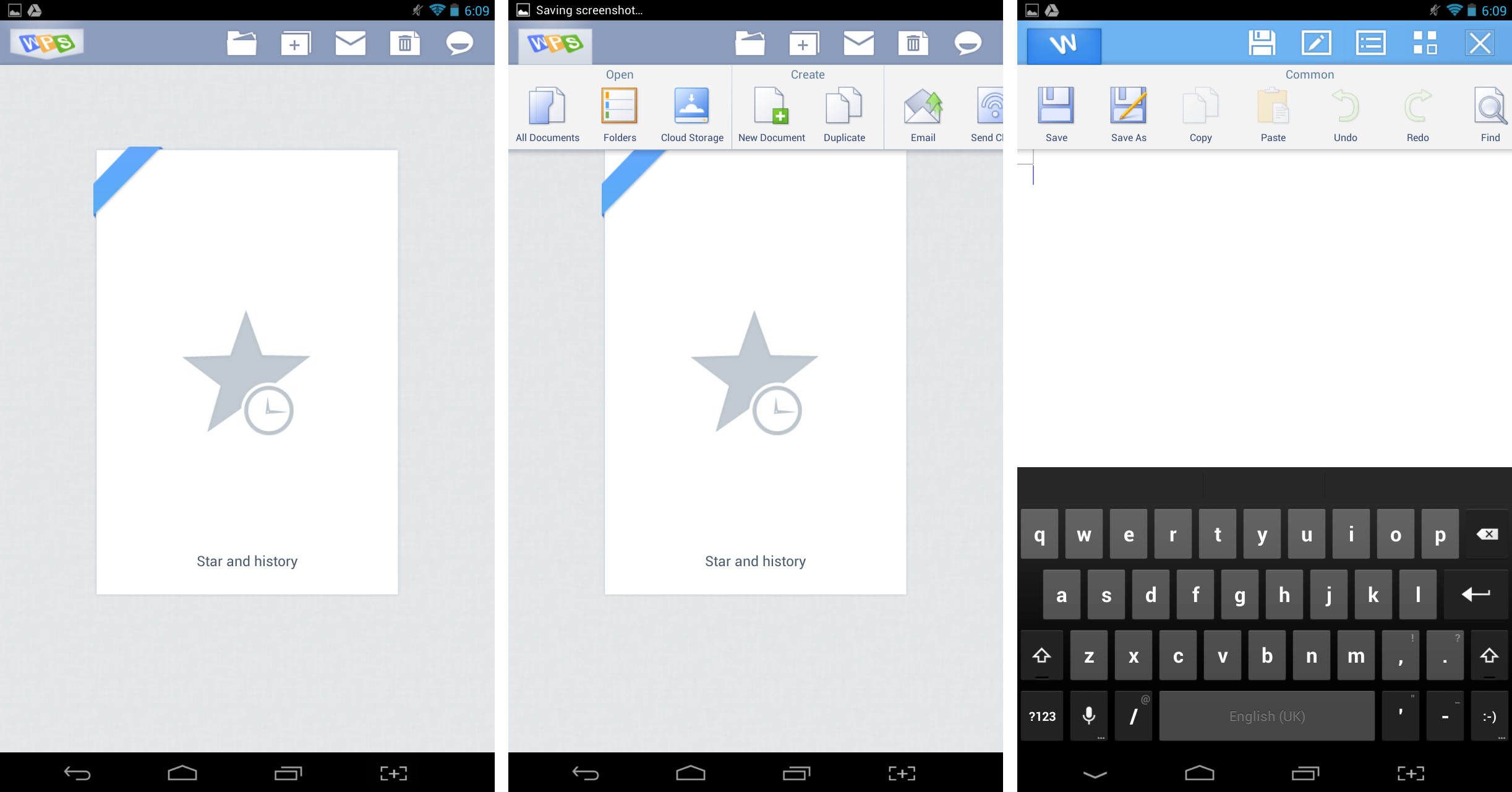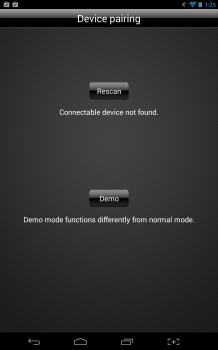The Sero 7 Pro is Hisense’s first foray into the ultra-competitive tablet market, and they’ve chosen to model it on Google’s Nexus 7. Since the Nexus 7 proved that there was a viable market for 7-inch Android tablets, almost every OEM out there has been clamouring for a piece of that pie. With the notable exception of Samsung, each manufacturer seems to be in a race to deliver the least skinned UI, while still doing something to differentiate themselves from their competition.
Hisense have won this contest hands down, offering a 7-inch tablet with a build of Android so close to AOSP that it could masquerade as a Nexus device. The trouble for Hisense is that the Nexus 7 is a dynamite tablet and there isn’t much that the Sero can offer to entice consumers to buy it over the Nexus or one of Samsung’s popular tablets. Except for price, that is – the Sero 7 Pro retails for $198. We all know how bad cheap Android tablets can be, but is Hisense’s first tablet worth the price? Let’s find out!
- Pretty much stock Android
- Solid build
- Excellent colour reproduction and viewing angles
- 1 GB RAM
- 1280×800 display
- 8 GB storage
Hardware
The spec sheet for the Sero 7 Pro is nothing to write home about – 7-inch 1280×800 display, nVIDIA Tegra 3 system-on-a-chip, 1 GB RAM, 8 GB storage – and we’ve already seen a lot of this same hardware before in last year’s Nexus 7. That isn’t meant as a criticism though as the Nexus 7 was one of the most popular tablet computers of all time, and Hisense have clearly attempted to capitalise on its popularity for their first foray into the ultra-competitive tablet market. The specs aren’t great, but they’re decent and top-of-the-line performance clearly was not what Hisense were aiming for with the Sero. The only part of Hisense’s specs that I take issue with is the lack of storage space – 8 GB is not enough – but thankfully they’ve included a micro SD card slot, which you would absolutely need to use if you owned this tablet.
The back and sides of the Sero 7 Pro are made from a textured soft-touch plastic that not only feels nice, but helps keep the tablet in your hand if you have a tendency to be a bit clumsy (as I do). The plastic slightly wraps around the front of the tablet, which looks nice, but also secures the screen in the case, thus reducing flex, which was a bit of a problem for the Nexus 7.
The power button and volume rocker are in the ‘normal’ position for Android devices – the right-hand edge of the tablet, and both buttons feel solid but still push in easily with a satisfying click. The top edge is where all the Sero’s connections live – micro-USB port, mini HDMI, 3.5 mm headphone jack and micro-SD card slot. Having the micro-USB port at the top of the device is a bit strange, and can be quite annoying if trying to use the tablet while it is charging. The microphone is also located on the top edge of the device.
The front of the tablet is plain – no logos here – with only the 7-inch display, 2 megapixel front-facing camera and light sensors on this face.
The left-hand and bottom edges of the Sero have no buttons or ports, while the rear of the device houses the 5 megapixel camera (and flash) as well as the NFC antenna, which is helpfully identified by a sticker on the back. Below the NFC antenna are the Sero’s twin speakers, which produce decent sound, but were nothing special.
Build
The Sero 7 Pro is not a svelte device. At 10.8mm thick, it’s only 0.3mm thicker than last year’s Nexus 7, but it feels a lot thicker in the hand, and you know you’re holding something solid and well-constructed. The edges are rounded, but don’t taper out to create the illusion of thinness that manufacturers love so much, and weighing in at 360g, the Sero is 20g heavier than the 2012 Nexus 7 and 60g heavier than Samsung’s 7-inch Galaxy Tab 3. Despite its extra weight, I didn’t find the tablet burdensome and actually preferred it to my other Android tablet, the ultra-light Galaxy Note 8.0.
As I mentioned above, the soft-touch plastic that makes up the rear cover of the Sero actually wraps around the front of the tablet slightly, making it feel sturdier, but it also looks quite nice. The back cover is not removable so you’re stuck with the Sero’s 4000mAh battery for the life of the device.
Screen
Despite the relatively low resolution of 1280×800, the Sero Pro’s 7-inch IPS LCD screen is actually quite excellent. It obviously doesn’t have the crispness of the higher resolution displays that we all love so much, but colours are vibrant, blacks are deep and viewing angles are superb. The display is calibrated to a fairly warm white point, which I actually preferred to the cooler whites on my HTC One.
Connectivity
The Sero 7 Pro has the full swag of connectors on the top – micro-USB, micro-SD, 3.5 mm headphone, and even a mini-HDMI output to mirror the device’s screen to your TV or monitor. Unfortunately, the Sero doesn’t come with a mini-HDMI cable in the box, and it’s not exactly something that you’d have just lying around and so I don’t know how useful it would be. Like all other Tegra 3 tablets, the hardware is capable of Miracast device mirroring, but thanks to a lack of drivers from nVIDIA, the Sero’s software doesn’t support wireless displays.
In terms of wireless connectivity, the Sero supports Wi-Fi b/g/n at both 2.4GHz and 5GHz bands, as well as Bluetooth 3.0 + EDR and NFC.
Performance
Hisense decided to give their first tablet computer largely the same internals as the Nexus 7 – 1.3 GHz Tegra 3 system-on-a-chip with 1 GB of RAM – and accordingly, you’d expect it to have pretty much the same performance. While the Tegra 3 is pretty great for gaming, it has been known to deliver less-than-stellar performance when doing basic OS functions like scrolling web pages or switching between applications.
As a comparison, I loaded up the Sero 7 Pro and the Nexus 7 with all the same applications, and I found that the Nexus struggled a lot more than the Sero. It’s possible that Hisense have done some behind-the-scenes optimisation for their device, but it’s also possible that the Sero uses different flash memory than the Nexus 7, whose performance issues have been found to be (at least partially) as a result of Asus’ flash memory. Either way, the Sero performs slightly better in real-world use than the Nexus 7 running Android 4.2, but is still far outmatched by devices with Qualcomm internals.
Another issue is that the Sero only has 1 GB of RAM, which hasn’t been enough to reliably run Android since Ice Cream Sandwich. Still, the Sero is a cheap tablet after all, and it’s not that bad as long as you keep your multitasking down to 2-3 applications.
For those of you who are interested in benchmarks, the Sero scored 1306 in Geekbench 2 (173 points lower than the Nexus 7) and an average FPS of 45.2 in Epic Citadel (an Unreal Engine 3 benchmarking tool).
Battery life
The Sero has a non-removable 4000mAh battery, which Hisense estimates as having between 7-10 hours uptime, depending on what you’re using it for. This claim checked out in my testing – the tablet would easily get me through the day on moderate use and even heavy use would last at least until I got home to charge it. If you only use your tablet for reading a book on the morning and evening commutes to work, you could probably go three days without needing to charge it.
Of course, the battery life was helped by Hisense’s power settings, which let you set performance profiles depending on whether you want the best performance, or long battery life.
Camera
I still don’t understand why tablets even have rear cameras, let alone why people use them. Tablet cameras take notoriously bad pictures and you look like a technologically-inept jackarse if you hold up a 10-inch tablet to take a photo. Granted, taking photos with a 7-inch tablet doesn’t look quite as stupid as using an iPad, but the image quality was nothing to write home about.
The sensor takes forever to crank out an image, and unless you’re outdoors in bright sunlight, just don’t bother. You can see what I mean in the photo below inside Melbourne’s iconic Manchester Unity building. Outdoor photos don’t look too bad until you zoom in, whereupon you will notice just how blurry they are.
Macro images were surprisingly good, and I was impressed at how close to the object I could get before the camera would no longer focus. In that regard, the camera on the Sero 7 Pro outperformed the camera on my HTC One.
The 2 megapixel front-facing camera is basically what you’d expect from a tablet computer. You could Skype with it, or have an impromptu Hangout, but if I wouldn’t whip out your Sero to take a selfie with the Fonz.
Software
Android OS version
Even though the Sero 7 Pro isn’t running the latest version of Android – it comes with Android 4.2.1 out of the box – Hisense seem to have realised that software is not their forte, and accordingly have kept the experience very close to AOSP, only adding in a couple of their own enhancements.
Mostly stock Android
The first is the power saving mode that I’ve mentioned previously. In the Sero’s settings, there is an option for ‘Power saving mode’, which lets you choose between different performance profiles depending on how you use the device. The default is ‘performance priority mode’, which sets the tablet to achieve optimal performance at the cost of long battery life. The second option, and the one that I found to be the best balance of performance and battery, is the ‘balanced mode’; while the last is a ‘power save mode’ that cranks everything down to squeeze a couple extra hours out of the battery.
Power save mode is a great feature, and I wish that Google would include something similar in AOSP, but I would have liked the ability to automatically switch profiles at certain battery levels.
The second UI customisation Hisense chose to make is a strange one – apparently the old ‘volume down + power’ keypress combination was too difficult, and an omnipresent button on the navigation bar was the best way to take a screenshot. I have to question the motivation for this – do people really take screenshots that often that a permanent button is warranted? When I went into this review, I expected this to bother me a lot, particularly since the extra button meant that the home button was no longer placed in the centre of the display. I was surprised then to find that the more I used the tablet, the less the lopsided home button actually bothered me, although I still would have liked the option to remove the screenshot button from the nav bar.
Bundled applications
Normally, this is where you’d get a rundown of the custom applications that ship on the device being reviewed, but Hisense have made that quite difficult for us by only bundling two applications with the device – Kingsoft Office and a remote control app for Hisense televisions – both of which can be easily uninstalled from the device.
Kingsoft Office is a free application that lets you view, edit and create Word, Powerpoint and Excel documents on your Android device. It looks to be fairly good, and claims to be fully-featured but I still found it cumbersome to use. Office is not great on a touch screen, although if you absolutely need to get some work done on your tablet, Kingsoft seems better than most alternatives.
The remote control application is sadly Wi-Fi only, as the Sero does not have an IR blaster. It also only works with Hisense televisions, and since I don’t own a Hisense television, I couldn’t put it to the test. It certainly is ugly though – like bad iOS port ugly – and when being demoed by Hisense, the application crashed a couple of times when trying to connect. To be fair, the demo took place in a room filled with Hisense televisions and it’s possible that the app simply didn’t know which one to connect to, and for most readers, this is unlikely to be a problem.
Sadly, even though the software is almost pure Android, I don’t have a lot of confidence that Hisense will put many resources into delivering timely updates to future versions of Android for the device. If future updates are important to you, then the Sero 7 Pro may not be the right purchase.
Hisense
Sero 7 Pro
- 7-inch 1280 x 800 IPS LCD display
- 1.3 GHz nVIDIA Tegra 3 system-on-a-chip
- 1 GB RAM
- 8 GB storage, with up to 32 GB micro-SD expansion
- 5 megapixel rear camera with flash, 2 megapixel front camera
- Wi-Fi 802.11b/g/n, Bluetooth 3.0, NFC
- Mini-HDMI output
- 5 MP rear camera, 2 MP front-facing camera
- Android 4.2.1 (Jelly Bean)
- 4000 mAh battery
- 199.8 x 125.8 x 10.8mm, 360g
- $198 at JB Hi-Fi, Harvey Norman, The Good Guys, Joyce Mayne and Betta Home Living
Conclusion
On the Sero Pro’s web page, Hisense ask ‘what makes Sero 7 so different from the rest?’ I find this to be an interesting question because there isn’t really anything that makes the Sero stand out above other tablets. Hisense have built a solid tablet, taking the great specs and low price point of the Nexus 7, and wrapping it up in a more sturdy case than the one Asus built.
I would happily recommend the Sero 7 Pro to anyone who wanted a cheap Android tablet and didn’t mind that it may never be updated. The lack of storage is a problem for me, but I know that there are many people out there who won’t see this as a big deal, considering the Sero’s micro-SD card slot. If you’re willing to spend an extra $50, you may be better off with a 2012 Nexus 7 (if you can manage to still get your hands on one), which has double the storage and a guarantee to see the next few versions of Android, but if you want to stay under $200, there is no real competition for the Sero 7 Pro.







What’s missing from the Sero 7 Pro you reviewed is 3G data and phone. It is annoying to see how few tablets are released with both. As it is though, it does look like a competently viable entry level 7in WiFi only tablet. What’s missing from the review is what sensors the Sero has.